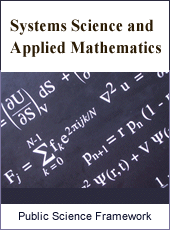Systems Science and Applied Mathematics
Articles Information
Systems Science and Applied Mathematics, Vol.1, No.3, Dec. 2016, Pub. Date: Jan. 9, 2017
Design of FIR Smoother Using Covariance Information for Estimating Signal at Start Time in Linear Continuous Systems
Pages: 29-37 Views: 4685 Downloads: 1104
[01]
Seiichi Nakamori, Department of Technology, Faculty of Education, Kagoshima University, Kagoshima, Japan.
This paper, as a first attempt, examines to design the recursive least-squares (RLS) finite impulse response (FIR) smoother, which estimates the signal at each start time of the finite-time interval in linear continuous-time stochastic systems. It is assumed that the signal is observed with additive white noise and is uncorrelated with the observation noise. It is a characteristic that the FIR smoother uses the covariance information of the signal process in the form of the semi-degenerate kernel and the variance of the observation noise besides the observed value. This paper also presents the recursive algorithm for the estimation error variance function of the RLS-FIR smoother to show the stability condition of the smoother.
FIR Smoother, Linear Continuous-Time Stochastic Systems, Wiener-Hopf Integral Equation, White Observation Noise, Convolution Integral
[01]
Kwon, W. H. and Kwon, O. K. (1987). FIR filters and recursive forms for continuous time-invariant state-space models, IEEE Trans. Automatic Control, 32 (4): 352–356.
[02]
Jazwinski, A. H. (1968). Limited memory optimal filtering, IEEE Trans. Automatic Control, 13 (5): 558–563.
[03]
Schweppe, F. C. (1973). Uncertain Dynamic Systems, Prentice-Hall, Englewood Cliffs,
[04]
N. J. Bruckstein, A. M. and Kailath, T. (1985). Recursive limited memory filtering and scattering theory, IEEE Trans. Information Theory, 31 (3): 440–443.
[05]
Kwon, W. H., Kim, P. S. and Park, P. G. (1999). A receding horizon Kalman FIR filter for linear continuous-time systems, IEEE Trans. Automatic Control, 44 (11): 2115–2120.
[06]
Han, S. H. Kwon, W. H and Kim, P. S. (2001). Receding-horizon unbiased FIR filter for continuous-time state-space models without a priori initial state information, IEEE Trans. Automatic Control, 46 (5): 766–770.
[07]
Kwon, W. H., Kim, P. S. and Park, P. G. (1999). A receding horizon Kalman FIR filter for discrete time-invariant systems, IEEE Trans. Automatic Control, 44 (9): 1787–1791.
[08]
Ahn, C. (2008). New quasi-deadbeat FIR smoother for discrete-time state-space signal models: an LMI approach, IEICE Trans. Fundam. Electron. Commun. Comput. Sci., vol. E91-A (9): 2671–2674.
[09]
Ahn, C. K. and Han, S. H. (2008). New H_∞ FIR smoother for linear discrete-time state-space models, IEICE Trans. Commun., E91-B (3): 896–899.
[10]
Nakamori, S. and Sugisaka, M. (1977). Initial-value system for linear smoothing problems by covariance information, Automatica, 13 (6): 623–627.
[11]
Nakamori, S. (2009). RLS fixed-lag smoother using covariance information in linear continuous stochastic systems, Appl. Math. Model., 33 (1): 242–255.
[12]
Nakamori, S. (2007). Design of extended recursive Wiener fixed-point smoother and filter in discrete-time stochastic systems, Digital Signal Processing, 17 (1): 360–370.
[13]
Nakamori, S. (2010). Design of RLS Wiener FIR filter using covariance information in linear discrete-time stochastic systems, Digital Signal Processing, 20 (5): 1310-1329.
[14]
Nakamori, S. (2013). Design of RLS-FIR filter using covariance information in linear continuous-time stochastic systems, Applied Mathematics and Computation, 219: 9598-9608.
[15]
Nakamori, S. (2014) Design of RLS Wiener FIR fixed-Lag smoother in linear discrete-time stochastic systems, CiiT International Journal of Programmable Device Circuits and Systems, 6 (8): 233-243.
[16]
Sage, A. P., Melsa, J. L. (1971). Estimation Theory with Applications to Communications and Control, McGraw-Hill, New York.
[17]
Kagiwada H. H. and Kalaba, R. E. (1968). Verification of the invariant imbedding method for certain Fredholm integral equations, Journal of Mathematical Analysis and Applications,. 23 (3): 540-550.
[18]
Kagiwada, H. H., Kalaba, R. E. and Vereeke, B. J. (1968). The invariant imbedding numerical method for Fredholm integral equations with degenerate kernels, Journal of Approximation Theory, 1 (3): 355-364.
[19]
Casti, J. L. and Kalaba, R. E. (1970). Proof of the basic invariant imbedding method for Fredholm integral equations with displacement kernels. Part II, Information Sciences, 2 (1): 69-76.
[20]
Bellman, R. and Ueno, S. (1973). Invariant imbedding and the resolvent of Fredholm integral equation with composite symmetric kernel, Jounal of Mathematical Physics, 14: 1489-1490.
[21]
Kagiwada, H. H., Kalaba, R. E. and Schumitzky, A. (1969). A representation for the solution of Fredholm integral equations, Proc. Amer. Math. Soc., 23: 37-40.
[22]
Kagiwada, H. H. and Kalaba, R. E. (1975). Integral Equation via Imbedding Methods, Addison-Wesley.
[23]
Koshel, K. V., Ryzhov, E. A. and Zyryanov (2014). V. N., A modification of the invariant imbedding method for a singular boundary value problem, Communications in Nonlinear Science and Numerical Simulation, 19 (3): 459-470.

ISSN Print: Pending
ISSN Online: Pending
Current Issue:
Vol. 2, Issue 2, April Submit a Manuscript Join Editorial Board Join Reviewer Team
ISSN Online: Pending
Current Issue:
Vol. 2, Issue 2, April Submit a Manuscript Join Editorial Board Join Reviewer Team
| About This Journal |
| All Issues |
| Open Access |
| Indexing |
| Payment Information |
| Author Guidelines |
| Review Process |
| Publication Ethics |
| Editorial Board |
| Peer Reviewers |


